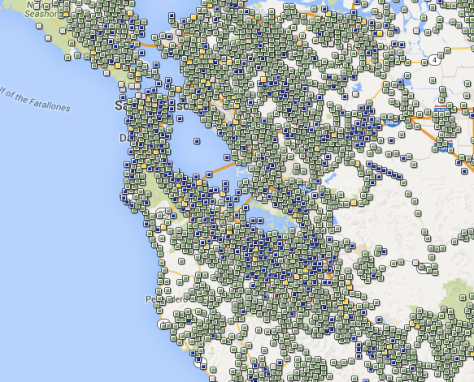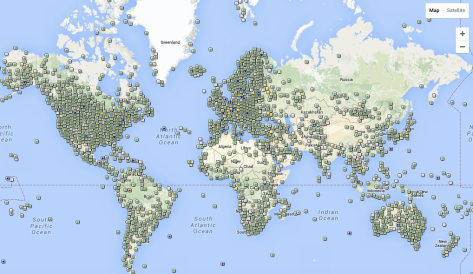This is a map of the geocaches around my house. (For a quick introduction to geocaching, see this page). The green-on-white boxes are the locations of caches yet to be found. The smileys represent the caches I’ve found already. The blue question marks represent puzzle caches, in which you have to solve a puzzle to get the exact coordinates, more my husband’s thing than mine.

I’m getting familiar with this map because since the beginning of 2016 I’ve been on a geocaching streak. My husband is an old hand at streaks too: a few years ago he did a 100 days in a row, and he has found a cache on every day of the calendar year, although not sequentially, since 2008 when we started.
I have neither of these milestones under my belt, but as this is a leap year, and I’ve found caches every day so far plus Dec 31, I’m interested in seeing how far this can go. There are still quite a few caches within walking or biking distance, that I can find when I’m out and about during the day.

If you zoom out a little bit, you can see from the number of caches visible that geocaching is big in the SF Bay Area–not surprising given the concentration of techno-geeks that live here. In fact, the world’s #1 geocacher, a person with more than 130,000 finds as of this writing, lives not too far from us. We’ve seen his caching name in some logs we’ve found recently, and are secretly hoping to meet him at an event some day (not that we’re cyberstalking him or anything).
Panning around the USA, one sees that geocaches tend to be hidden around cities, rivers, and roads. Sometimes they outline the features themselves:

Or sometimes, hiders get clever and make some “geo-art” out of the caches they hide.
I was talking to my blogging buddy, Mel Pine from Melting Pot Dharma, on Facebook yesterday about names, and I told him that the Allendoerfers had come over from Germany (where geocaching is also very popular) in 1848. He mentioned that his relatives had come from Pinsk, a small city in what is now Belarus, and were originally named Pinsky, changing it to Pine after immigrating. For fun, since I’d heard of Minsk but not Pinsk, I decided to look it up and see if there were any geocaches there. That’s something my family often does these days before we travel to a place.
I was surprised–actually rather shocked, even–to find, that there are no geocaches at all in Pinsk. There are a few to the Northeast in Minsk, but for the most part, Belarus is a cache-free zone. The caches come up to the border of Ukraine and Belarus like little green ants, or army men, and there they stop. A few look like they’ve spilled through and gotten lost, huddled together for warmth around the bigger cities of Minsk, Moscow, and Kiev.
If you look worldwide, geocaching can be seen as a marker for wealth and industrialization: there are lots of caches placed in North America, Europe, Scandinavia, South Africa, Japan, Australia, and New Zealand. Singapore, Taiwan, South Korea, Qatar, Bahrain, and Iceland are also well-represented in number of caches per square mile, although harder to see at this scale.

But there’s still the riddle of the empty map in Belarus and to the east. These countries have cell phones and GPS technology. The satellites orbit the entire earth. Why don’t people hide and find geocaches there? Does it have to do with the government? With internet access? With a perception that caches could be dangerous? Or something else?
In my novel, Hallie’s Cache, the characters stumble on an area where not only are there apparently no caches, but the GPS doesn’t work properly. Finding out the mysteries of this place is the key to the story and to Hallie finding her missing father.
Geocaching is a hobby that can be used to bring people together. I hope in the future many of these empty spaces can be filled in!






How interesting! I can’t wait to hear more about your book. The whole idea of it all is still very foreign to me!
LikeLiked by 1 person
I have many friends who like to geocache, I think it’s a great excuse to get out and wander!
Also wanted to mention that I nominated you for a Lovely Blog award, over at my blog. It’s one of those chain recognition things, so no need to participate. Just wanted to give you a shout out that I enjoy your blog 🙂
LikeLiked by 1 person
Well, I’m not shy to admit I’d never heard of geocaching until the first mention I caught from you a little while ago, when you said you were considering changing the name of your blog. Interesting hobby. What made you get into it?
LikeLiked by 1 person
We went first with one of my husband’s friends and his family. Then my husband kind of picked up the ball and ran with it.
LikeLiked by 1 person
I tell people that my parents were too poor and tired to give me a middle name, so I took my wife’s maiden name as my middle name, Now I can add that they came from a region so poor that they don’t have geocaches there. From what I’ve been able to read, I believe that the area is swampy. That may have something to do with it.
Years back, I was an avid scuba diver with an advanced certification. To get the advanced certification, you have to navigate a triangle under water using only your compass. The test is to get back to the point where you started. Geocaching reminded me of that.
LikeLiked by 1 person
There’s an activity called orienteering that sounds similar to that too. What’s funny is that I don’t have a very good sense of direction, unaided. GPS technology has been good for me and helped me not get lost so much!
LikeLiked by 1 person
I have no natural sense of direction. I rely entirely on the GPS in my car.
LikeLiked by 1 person
I’m rather shy to admit I didn’t even know such a pastime existed but you have given me enough info that this week my internet time will be devoted to findng out more.
Thanks 😊
LikeLiked by 1 person
I’m going to give a reading of my geocaching story, “Bobbing for Bob,” in the Mountain View Public Library in April. It will be part of an event that introduces geocaching to a wider audience. I am going to blog about that closer to the event, probably more than once.
LikeLiked by 1 person